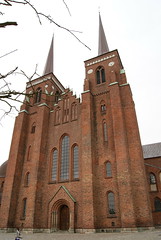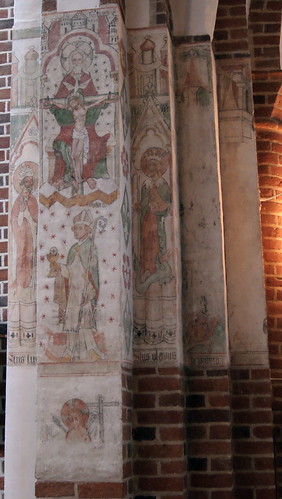One of the great things (or perhaps one of the curses) of working in the history of art is that holidays always have a work edge. If you are travelling in Europe, you are almost never too far from a medieval or renaissance site that needs seeing. I’ve recently spent some time in Denmark, and  while I was there I couldn’t resist taking the train out to the small town of Roskilde, once the capital of the Viking kingdom of Denmark.
while I was there I couldn’t resist taking the train out to the small town of Roskilde, once the capital of the Viking kingdom of Denmark.
Roskilde boasts an impressive cathedral, which for anyone used to English or French buildings of the same date is something of a surprise. Take a look at the photo, and you’ll see what I mean. It’s built almost entirely of brick – and Roskilde claims to be the first cathedral ever to have been built using that material. It was mainly constructed in the early thirteenth century, and already shows signs of responding to the gothic style that had developed in the area around Paris in the previous forty or fifty years. This new brick-built style was so influential in Denmark that many of the nineteenth and twentieth-century churches there still refer to Roskilde in their basic appearance.
Inside, the church is surprisingly small for a cathedral and burial site of kings, but there are interesting traces of medieval and renaissance wall painting surviving. This thirteenth-century painting caught my eye. The saint on the right is Olaf, the eleventh-century king of Norway who was an important saint throughout Scandinavia – it’s hard to make him out in the photo at this size, but you can see a much larger version on our Flickr pages.
The V&A doesn’t possess much material from medieval Scandinavia, but we do have one important piece that also depicts Olaf. It is a fourteenth-century crozier, and is almost certainly Norwegian – a piece that is very close to my heart, and forms part of a display looking at the international penetration of the gothic style in the thirteenth and fourteenth centuries in our new galleries (Gallery 9). You can take a look at it by clicking here: http://collections.vam.ac.uk/item/O65808/crozier-head-crozier/.
While I was in Roskilde, I also had to visit one other key site. In the 1970s, five Viking ships were salvaged from the fjord at Roskilde, and now form the centrepieces of a museum looking at the Viking relationship to the sea. The museum, which is also a working boat yard, is called the Vikingeskibs Museet. The display is very dramatic, as you are standing next to ships that are over a thousand years old. Outside in the harbour are authentic replicas, built using traditional techniques. Probably the most effective, and moving, part of the museum displays is the high-quality film showing a crew from Roskilde attempting to sail the largest of their ship replicas to Dublin. Why Dublin? Well, scientific testing has shown that the largest ship at Roskilde had been made there. The crew do succeed in making their way to Dublin, but not without being tested in appalling conditions. I felt very happy to be watching, rather than taking part!
If you want to see some of the awesome footage for yourself, then click here: http://vikingeskibsmuseet.dk/index.php?id=1671&L=1.
I found the visit strangely moving. It was something to do with the fact that the ships are displayed so close to their find site, and in the context of practical archaeology. You’re encouraged to think about how the Viking community in Roskilde actually lived, and you come out of the museum with a sense of quite how adventurous these sea-farers were.
